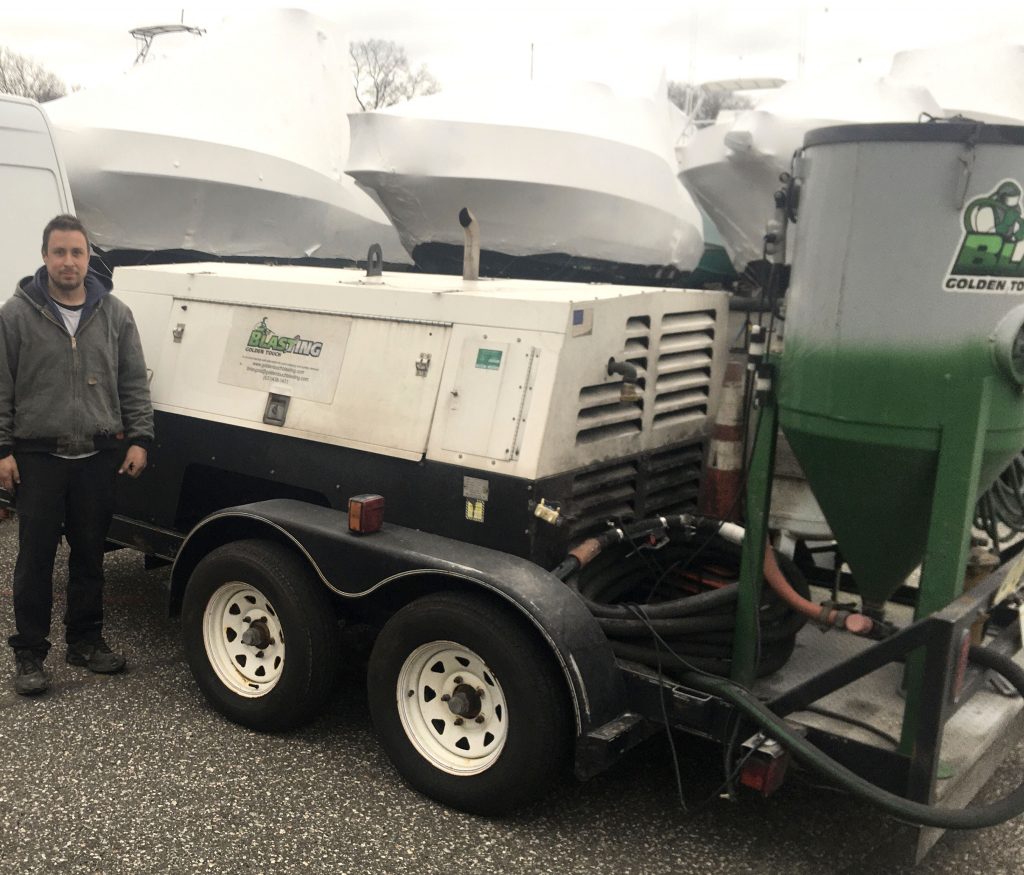
Maybe you have an older boat or you just purchased your dream boat during quarantine and you’re not confident regarding its history. During a boat’s life, if you haven’t hit submerged debris or bottomed out your either amazingly lucky, or you own a floating condo that doesn’t leave the dock. If you have a boat with some nautical miles behind her and a large build-up of bottom paint. It is always a good idea to take a good look at what’s going on below the waterline. Doing so early may catch concerns before they accumulate into large problems. To do this you must hire a professional to come and strip back the layers of this onion. It is a huge job that has environmental concerns that must be done by a pro. Simply sanding the bottom will not work. This job requires soda blasting.

What is Soda Blasting?
Most people are familiar with the process known as sandblasting. Soda blasting is a similar abrasive technique used to remove paint, rust, and other layers to bring materials back to their original state. While it is technically used as an abrasive process, many professionals in the field consider soda blasting a non-abrasive technique or the least abrasive blasting medium. Specially granulated sodium bicarbonate (baking soda) is applied at high pressure to a surface to remove the desired layers restoring the original surface. Since sodium bicarbonate shatters on impact, it is much gentler than sandblasting. This is why it is perfect when working with fiberglass hulls. It is also suitable for use with most metals, wood, plastics, and even glass. This makes it perfect considering running gear, transducers, underwater lights, and other possible materials your boat may have. Soda blasting is environmentally friendly and biodegradable making it perfect for the marine environment and outdoor use.
You will need to arrange through your boatyard who is permitted to do this procedure. For my boat, I used Golden Touch Blasting out of Brookhaven, NY (https://www.goldentouchblasting.com/). Brian Gold owner-operator personally handles the process. Golden Touch Blasting is mobile which makes them ideal for any marina, or private individual looking to remove the paint from their boat’s surface. When the process is complete baring any repairs, you will have a surface that is for the most part prepared for the primer to be applied. Most jobs 40 feet and under can be done in 1 day. Another option on Long Island is Blast Away Corp., Mike Fortunato has over 10 years of experience and also does engine detailing as well as fabric and Interiors. Remember to check with your yard to see who they are comfortable with. Whoever you pick even if coming to your home, make sure they are licensed and insured.
The Process:
The entire bottom of the boat is tented (sides and bottom) to catch all blasting residue, both old paint and the used blasting medium. This is particularly important since most antifouling paints contain cuprous oxide, which is not a friend of the environment. Specialized soda blasting machinery is used for the process and workers are suited up in full protective suits resembling hazmat gear. Weather, mostly wind and rain can and will postpone your projected workdays. If it’s too windy the tented sides blow around making it difficult to work. Regardless of the size of your boat, this is a massive job that cannot be done by the “do it yourself” with palm sanders.
When the workers are done and cleaned up it’s time to inspect the hull. At minimum wear an n 95 or similar mask and disposable gloves. The dust on and around the hull is contaminated. As you touch and inspect the area you will find spots where small piles may have settled. Cleaning these up with a shop vac is advised. As you make your inspection, have a magic marker handy to mark trouble spots. These spots include; blistering, cracks, pores, and soft spots. After marking your problem areas take a step back and decide how big of a job the next step will be. If the job is large in scale or requires major fiberglass repair it may be time to call in the pros. If you are really lucky you can get away with just applying barrier coats to fill in minor imperfections and move on. Barrier coat is a high build epoxy primer with a substrate in it. The substrate lays like roof shingles forming a layered waterproof barrier. For my project, I elected to use Pettit Barrier Coat. They have a specialized substrate that lays flat vs others that used microbeads. The flatter profile allows the barrier to set in a more evenly stacked manner requiring fewer coats. Fewer coats mean less time, money, thickness, and weight.
On my project, upon inspecting the bottom it was apparent that some minor filler would be needed in some areas. There were a few cracks from an underwater strike 3 seasons ago. There were some pores (pin dot holes) that needed filling and some minimal stress cracking. It is very common to find stress cracks in the areas where the boat is seasonally blocked for the winter. These are the bulkhead joints, near the fuel tank, and the area under the engines. These areas were all cleaned, prepped, and filled. Once dry they were all sanded to and even profile. Luckily there were no blisters. Blisters require more work as the delaminated sections should be completely removed, then they are prepped cleaned, and filled. When this was all finished its time to start sanding. The reason I needed to sand was to feather in my repairs and clean off any leftovers or spots that may have been missed.
Using a palm sander hooked up to a shop vac is the cleanest and easiest way to go. You may have noticed that there was no mention of cleaning the hull with soap and water yet. Soda blasting i a fairly clean process, but it does kick up some dust. It may be counterintuitive to skip this step, as cleanliness is next to godliness, but it was done on purpose. The residual dust from soda blasting acts like a sanding dry guide coat. As you sand it becomes very apparent where you missed. Once the entire surface has been sanded with 80 grit and all repairs are feathered smooth it’s time to prep the surface and paint. Please note, while sanding the hull is not entirely necessary, it gives you one last chance to meticulously go over the entire surface before priming. Keep the magic marker handy in case you find other imperfections.
The soda blasting process can and will create a good amount of dust. It is a smart idea to seal any openings such as engine room vents, hatches, thru-hull fittings, etc. When the process is complete, visually inspect and clean areas that may have accumulated dust. Tools necessary for clean up are; a shop vac, air compressor, and rags with soapy water. If you have inboards don’t forget to blow out the cutlass bearings. Again wearing eye protection a mask and gloves are important precautions to keep you safe and healthy. Next month we will discuss primer and bottom paint.
